Comparison of traffic signs in English-speaking territories
This is a comparison of road signs in countries and regions that speak majorly English, including major ones where it is an official language and widely understood (and as a lingua franca).
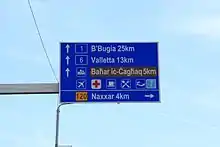
Among the countries listed below, Liberia, Nigeria, and the Philippines have ratified the Vienna Convention on Road Signs and Signals, while the United Kingdom has signed the convention but not yet ratified it.[1] Botswana, Eswatini, Lesotho, Malawi, South Africa, Tanzania, Zambia, and Zimbabwe are all Southern African Development Community (SADC) members who drive on the left and use the SADC Road Traffic Signs Manual. The Manual on Uniform Traffic Control Devices (MUTCD) used in the United States has also influenced signing practices in other countries.
Differences between traffic signs in English-speaking countries/regions
| Australia | Bahamas | Belize | Canada | Hong Kong | Ireland | Jamaica | Liberia | Mauritius | New Zealand | Nigeria | Philippines | South Africa | Malta | Singapore | United Kingdom | United States | Zimbabwe | |
|---|---|---|---|---|---|---|---|---|---|---|---|---|---|---|---|---|---|---|
| Drives on... | Left | Left | Right | Right | Left | Left | Left | Right | Left | Left | Right | Right | Left | Left | Left | Left | Right | Left |
| Speed units | km/h | mph | mph | km/h | km/h | km/h | km/h | km/h or mph[12] | km/h | km/h | km/h | km/h | km/h | km/h | km/h | mph | mph | km/h |
| Sign typeface | AS1744 (Highway Gothic variant) | Highway Gothic | Highway Gothic | Highway Gothic or Clearview | Transport or Helvetica | Transport or Motorway | Highway Gothic | Highway Gothic | Transport | Highway Gothic | Highway Gothic | Highway Gothic or Clearview | DIN 1451 | Transport | Local variety or DIN 1451 | Transport or Motorway | Highway Gothic or Clearview | DIN 1451 |
Differences in units
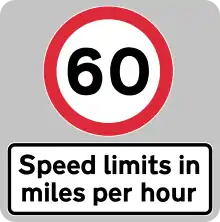
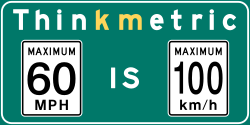
Note that the imperial speed limit (left) is shown using a Canadian-style sign, rather than an MUTCD-standard one as would be used in the US
- All main countries/regions, except for the United States and the United Kingdom, use the metric system. Some mark this fact by using units on various signs. Note that some smaller English-speaking countries in the Caribbean also use miles per hour.
- Ireland, parts of Canada (British Columbia, parts of Ontario, and Yukon), and Liberia[12] list units (km/h) on their maximum speed limit signs. In Canada and Ireland, this is a reflection of (somewhat) recent transitions from Imperial to metric.
- Advisory speed limit signs in most countries list units, although New Zealand does not. The US lists units in mph.
- Height, weight, and width restrictions are almost always accompanied by units (tonnes or metres); in the US, the short ton is used with no distinction from metric tonnes.
- Signs in some parts of Canada near the US border often include both metric and Imperial units, to remind American drivers that they are entering metric countries. No such equivalent exists in the US.[13]
- The US was, at one time, planning a transition to the metric system. The Metric Conversion Act of 1975 started the process, but the abolition of the United States Metric Board in 1982 significantly hampered conversion. Nevertheless, the MUTCD specifies metric versions of speed limit signs. Furthermore, Interstate 19 in Arizona is partially signed in metric.
Warning signs
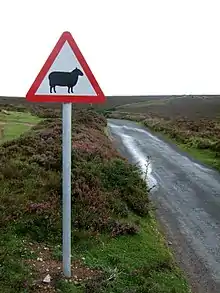
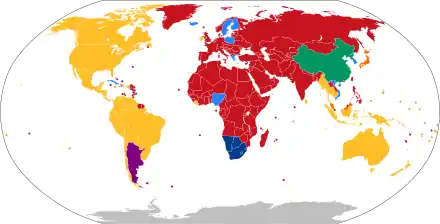
- Most warning signs are diamond-shaped and yellow or red-bordered triangular warning signs; some warning signs may be fluorescent yellow-green in order to draw extra attention. There are a few exceptions to this:
- Pentagonal signs are used in school zones in the United States, Liberia, and many areas in Canada. In the Philippines, pentagonal signs are permanently used for pedestrian crossings.
- Warning signs may be text-only.
Road works and construction
- Most countries use orange or yellow diamond-shaped signs or yellow, orange or white red-bordered triangular warning signs for construction zones. Australia and the Philippines use rectangular signs that fit into temporary casings.
Regulatory signs
- Prohibitory and restrictive signs are classified as regulatory signs.
- Almost all prohibitory signs use a red circle with a slash. Restrictive signs typically use a red circle, as in Europe. Some may be seated on a rectangular white background.
- The original MUTCD prohibitory and restrictive signs were text-only (i.e. NO LEFT TURN).[14] Some of these signs continue to be used in the US.
- Yield signs can be blank or have text with the legend "YIELD" or "GIVE WAY" depending on which country it is.
- The No Entry / Do Not Enter sign may or may not feature text. In Ireland, an upwards-pointing arrow contained within a slashed red circle is used instead. Some countries have those two signs separated.
- The Latin American-style do not proceed straight sign may take a different meaning in countries with standard No Entry signs. Typically, it indicates an intersection where traffic cannot continue straight ahead, but where cross-traffic may enter the street from the right (or left). Thus, it is distinguished from a No Entry (for all vehicles) sign.
Mandatory or permitted-action signs
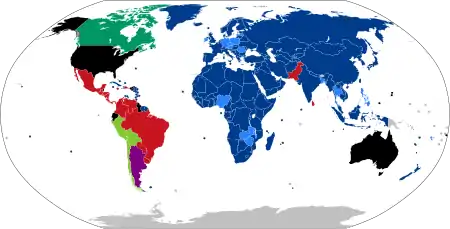
- The design of mandatory signs varies widely, since the MUTCD does not specify their use.[15] Rather, the MUTCD's equivalent are classified as regulatory signs.
- Some countries use simple arrows with the text "ONLY" or its equivalent underneath. This is the US and Australian standard.
- Some countries use European-style white-on-blue circular signs. These are "Type A Mandatory Signs" as prescribed by the Vienna Convention.
- Some Latin American countries use red-bordered circular signs, in the same style as regulatory signs. These are "Type B Mandatory Signs" as prescribed by the Vienna Convention. In cases relating to particular types of vehicle traffic (e.g. buses), these signs are identical to some European prohibitory signs.[lower-alpha 1]
- Canada uses a unique style of mandatory sign that features a green circle.
Warning
| Australia | Canada | Hong Kong | Ireland | Jamaica | Liberia | Mauritius | New Zealand | Nigeria | Philippines | SADC | Malta | Singapore | Uganda | United Kingdom | United States | |
|---|---|---|---|---|---|---|---|---|---|---|---|---|---|---|---|---|
| Stop sign ahead | 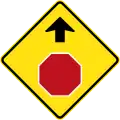 |
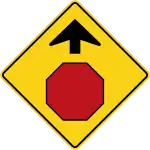 |
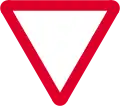 |
 |
 |
 |
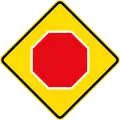 |
 |
 |
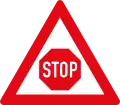 |
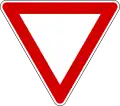 |
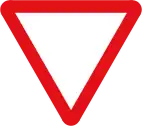 |
 | |||
| Yield / Give Way sign ahead | 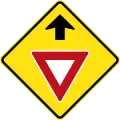 |
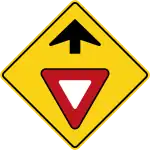 |
 |
 |
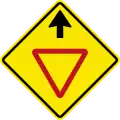 |
 |
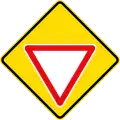 |
 |
 |
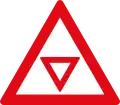 |
 |
 |
 | |||
| Traffic signals ahead | 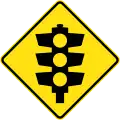 |
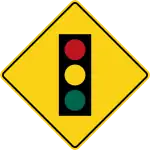 |
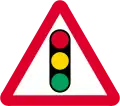 |
 |
 |
 |
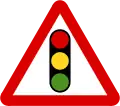 |
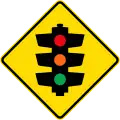 |
 |
 |
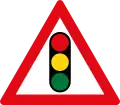 |
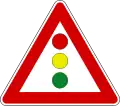 |
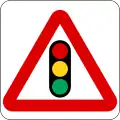 |
 |
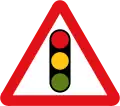 |
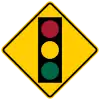 |
| Roundabout ahead | 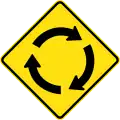 |
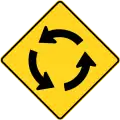 |
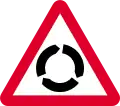 |
 |
 |
 |
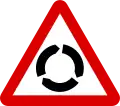 |
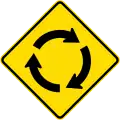 |
 |
 |
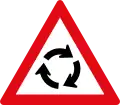 |
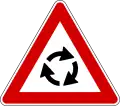 |
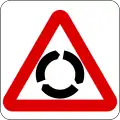 |
 |
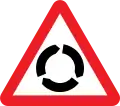 |
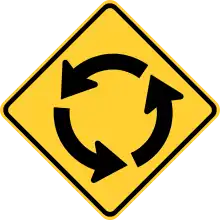 |
| Two-way traffic ahead | 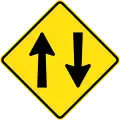 |
 |
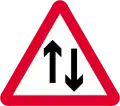 |
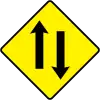 |
 |
 |
 |
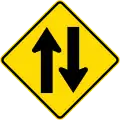 |
 |
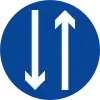 |
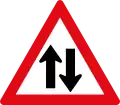 |
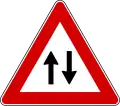 |
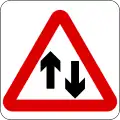 |
 |
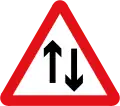 |
 |
| Uncontrolled railroad crossing ahead | 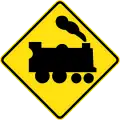 or 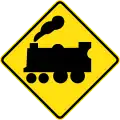 |
 |
Not used | 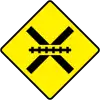 |
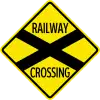 |
 |
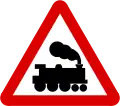 |
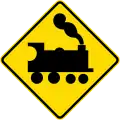 |
 |
 |
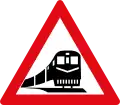 |
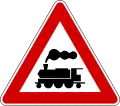 |
Not used[lower-alpha 2] | 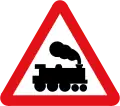 |
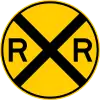 | |
| Level railroad crossing with barriers ahead | 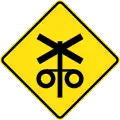 |
 |
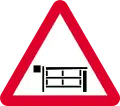 |
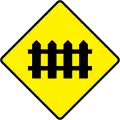 or 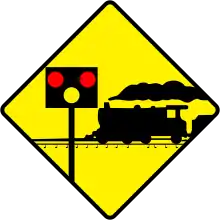 |
 |
 |
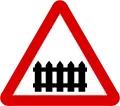 |
 |
 |
 |
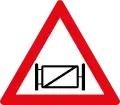 |
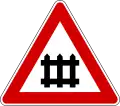 |
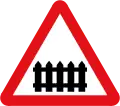 |
 | ||
| Tram / streetcar crossing | 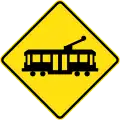 |
Not used | 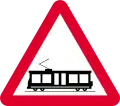 |
 |
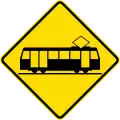 |
Not used[lower-alpha 3] |  |
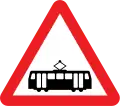 |
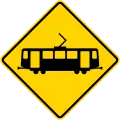 | |||||||
| Railroad crossbuck | or |
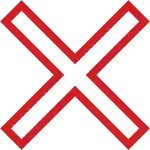 |
Not used |  |
or |
or |
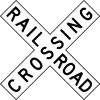 | |||||||||
| Level crossing (multiple tracks) | or .svg.png.webp) |
 |
Not used |  |
.svg.png.webp) or .svg.png.webp) |
 |
Not used |  |
Not used |  | ||||||
| Crossroads ahead | 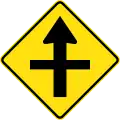 |
 |
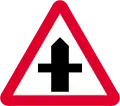 |
 |
 |
 |
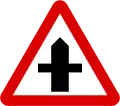 |
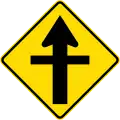 |
 |
 |
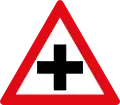 or[lower-alpha 4] 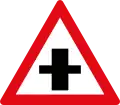 or[lower-alpha 5] 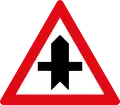 |
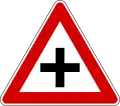 |
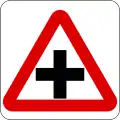 |
 |
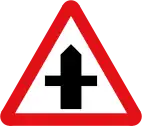 |
 |
| Junction with a side road ahead | 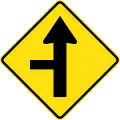 or 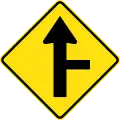 |
 |
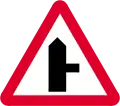 or  |
 |
 |
 |
.svg.png.webp) |
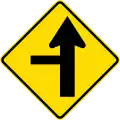 |
 |
 |
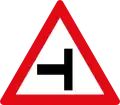 |
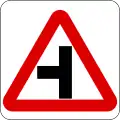 |
 |
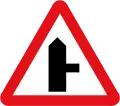 or  |
 | |
| Traffic merges ahead | 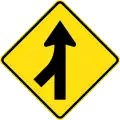 or 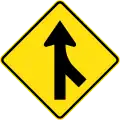 |
 |
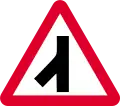 or 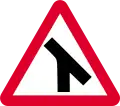 |
 |
 |
 |
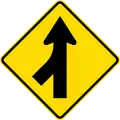 |
 |
 |
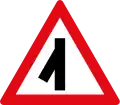 |
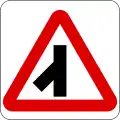 |
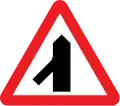 or 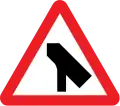 |
   | |||
| Added lane | 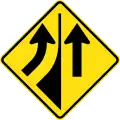 or 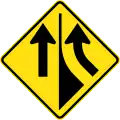 |
 |
 |
  | ||||||||||||
| Divided highway ahead | 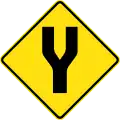 |
 |
 |
 |
 |
 |
 |
 | ||||||||
| Divided highway ends | 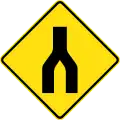 |
 |
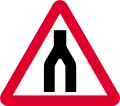 |
 |
 |
 |
 |
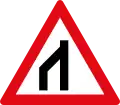 |
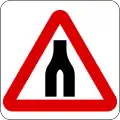 |
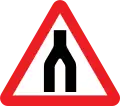 |
 | |||||
| Lane ends ahead | 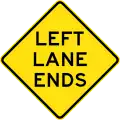 |
 |
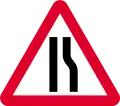 or 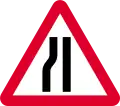 |
 |
 |
 |
 |
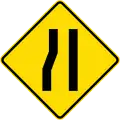 |
 |
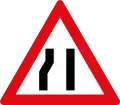 |
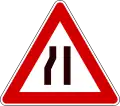 |
 |
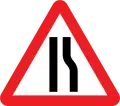 or  |
 | ||
| Road narrows ahead | 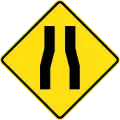 |
 |
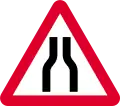 |
 |
 |
 |
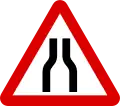 |
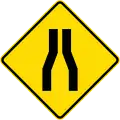 |
 |
 |
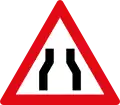 |
 |
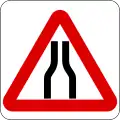 |
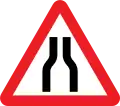 |
 | |
| Narrow bridge ahead | 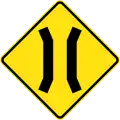 |
 |
 |
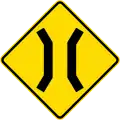 |
 |
 |
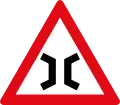 |
 |
 |
 | ||||||
| Dangerous crosswinds | 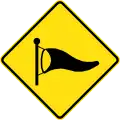 |
 |
Not used |  |
 |
 |
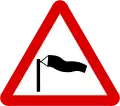 |
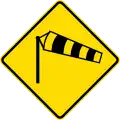 |
 |
Not used | 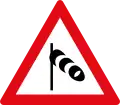 |
 |
Not used |  |
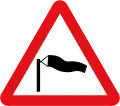 |
 |
| Low-flying aircraft | 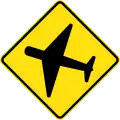 |
 |
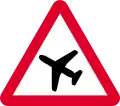 |
 |
 |
 |
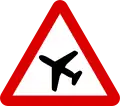 |
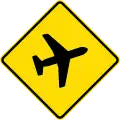 or 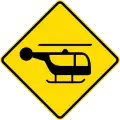 |
 |
 |
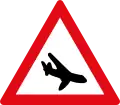 |
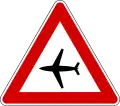 |
 |
 |
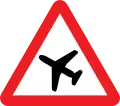 or  |
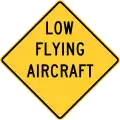 |
| Steep hill downwards | 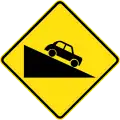 |
 |
.svg.png.webp) |
 |
 |
 |
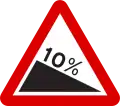 |
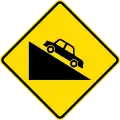 or 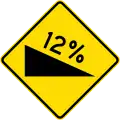 |
 |
 or  |
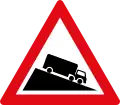 |
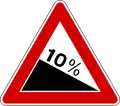 |
 |
 |
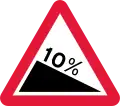 |
 |
| Steep hill upwards |  |
 |
.svg.png.webp) |
 |
 |
 |
 |
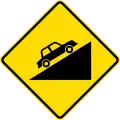 or 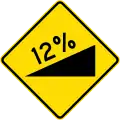 |
 |
 or  |
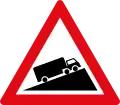 |
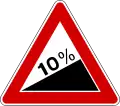 |
 |
 |
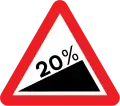 |
 |
| Uneven surface | 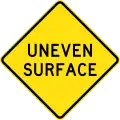 |
 |
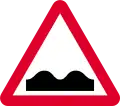 |
 |
 |
 |
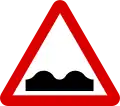 |
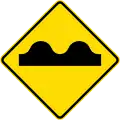 |
 |
 |
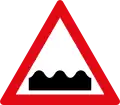 |
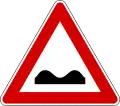 |
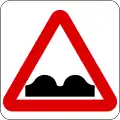 |
 |
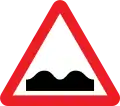 |
 |
| Dip in road | 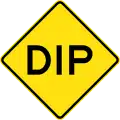 |
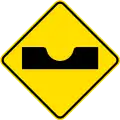 |
 |
 |
 |
 |
 |
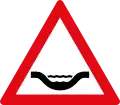 |
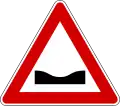 |
Not used |  |
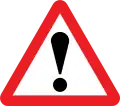 |
 | |||
| Bump in road | 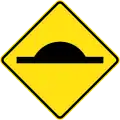 |
 |
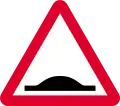 |
 |
 |
 or  [16] [16] |
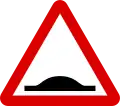 |
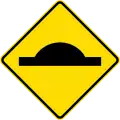 |
 |
 |
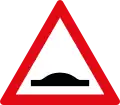 |
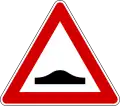 |
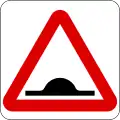 |
 |
 |
 |
| Slippery road surface | 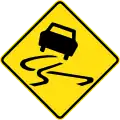 |
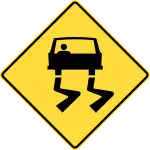 |
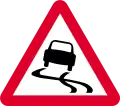 |
 |
 |
 |
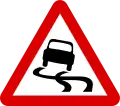 |
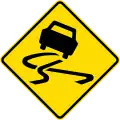 |
 |
 |
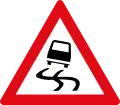 |
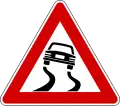 |
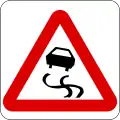 |
 |
 |
 |
| Loose road surface |  |
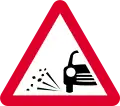 |
 |
 |
 |
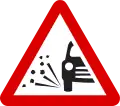 |
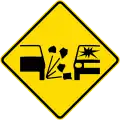 |
 |
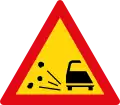 |
 |
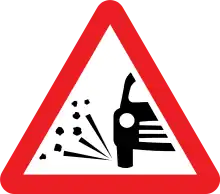 |
 | ||||
| Pavement ends | 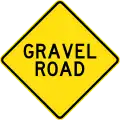 |
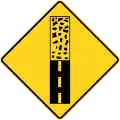 |
 |
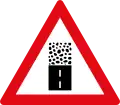 |
 | |||||||||||
| Gentle curve ahead |  or 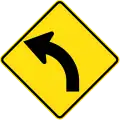 |
 |
 |
 |
 |
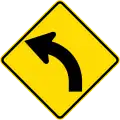 |
 |
 or  |
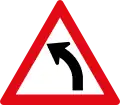 |
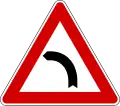 |
 | |||||
| Sharp curve ahead | 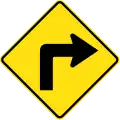 or 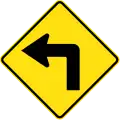 |
 |
 or 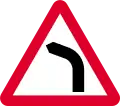 |
 |
 |
 |
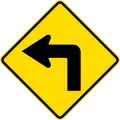 |
 |
 or  |
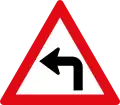 |
 |
 |
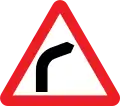 or  |
 | ||
| Double gentle curve ahead | 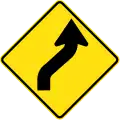 or 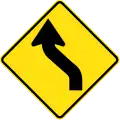 |
 |
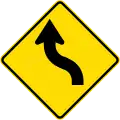 |
 or  |
 | |||||||||||
| Double sharp curve ahead | 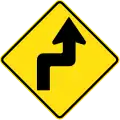 or 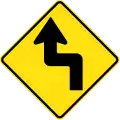 |
 |
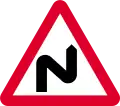 or  |
 |
 |
 |
 |
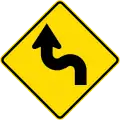 |
 |
 or  [lower-alpha 6] [lower-alpha 6] |
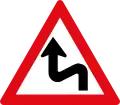 |
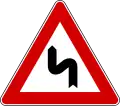 |
 |
 or 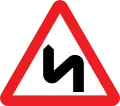 |
 | |
| Series of curves ahead | 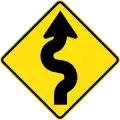 or 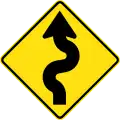 |
 |
 |
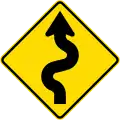 |
 or 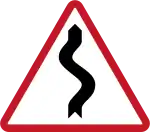 |
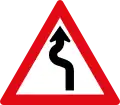 |
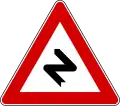 |
 |
 | |||||||
| Hairpin curve ahead | 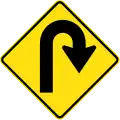 or 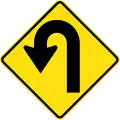 |
 |
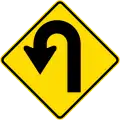 |
 or  |
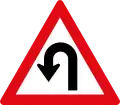 |
 |
 | |||||||||
| Chevron (short turn) | .svg.png.webp) |
 |
 |
 |
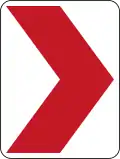 |
 |
 |
 |
 | |||||||
| Chevron (sharp turn) | ||||||||||||||||
| School zone | .svg.png.webp) or[lower-alpha 7] 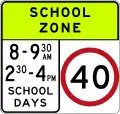 or  |
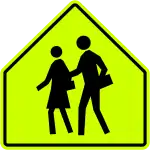 |
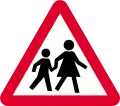 |
 |
 |
 |
 |
 |
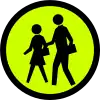 [lower-alpha 8] |
 | ||||||
| Children / playground ahead | 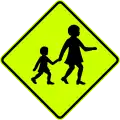 |
 |
 |
 or  |
 |
 |
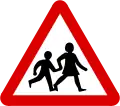 |
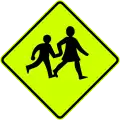 |
 |
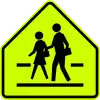 |
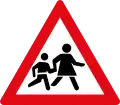 |
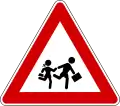 |
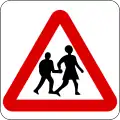 |
 |
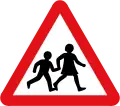 |
 |
| Pedestrian crossing ahead | 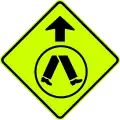 |
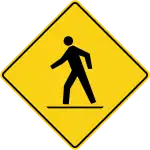 |
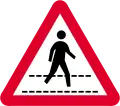 |
 |
 |
 |
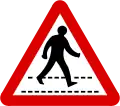 |
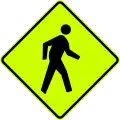 or 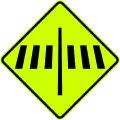 |
 |
 |
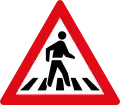 |
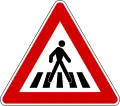 |
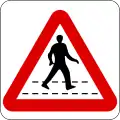 |
 |
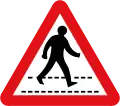 |
.svg.png.webp) |
| Pedestrians on road ahead |  |
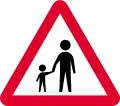 |
 |
 |
 |
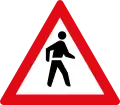 |
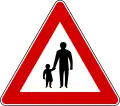 |
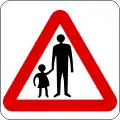 |
 |
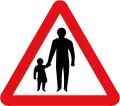 |
.svg.png.webp) | |||||
| Domestic animals | 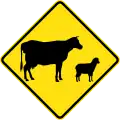 |
 |
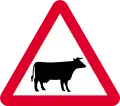 |
 |
 |
 |
_crossing.svg.png.webp) |
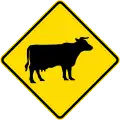 |
 |
 |
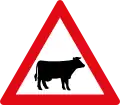 |
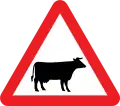 or  |
 | |||
| Wild animals | 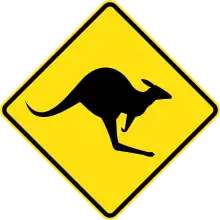 |
 |
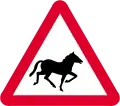 |
 |
 |
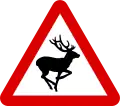 |
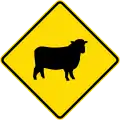 |
 |
Not used | 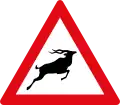 |
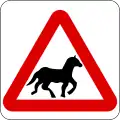 |
 |
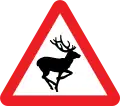 or 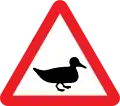 or 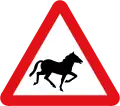 |
 | ||
| Cyclists crossing | 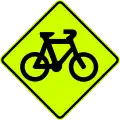 |
 |
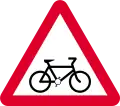 |
 |
 |
 |
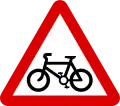 |
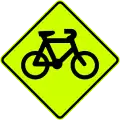 |
 |
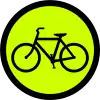 |
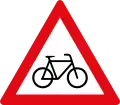 |
 |
 | |||
| Trucks crossing | 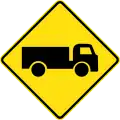 |
 |
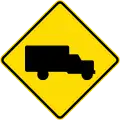 |
 | ||||||||||||
| Equestrians | 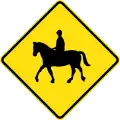 |
 |
 |
 |
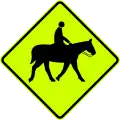 |
Not used | 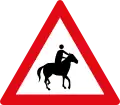 |
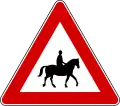 |
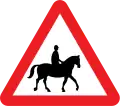 |
 | ||||||
| Emergency vehicles | 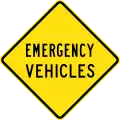 |
 |
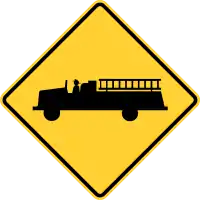 |
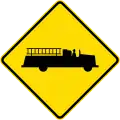 |
Not used |  | ||||||||||
| Farm vehicles | 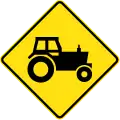 |
 |
 |
 |
Not used | 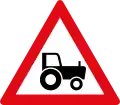 |
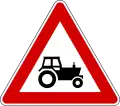 |
 |
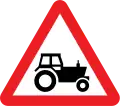 |
 or  | ||||||
| Falling rocks or debris | 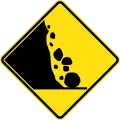 |
 |
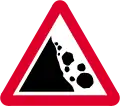 |
 |
 |
 |
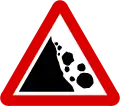 |
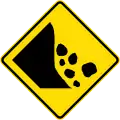 |
 |
 or  |
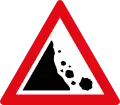 |
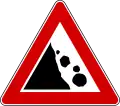 |
 |
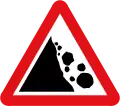 |
 | |
| Opening or swing bridge | 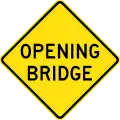 |
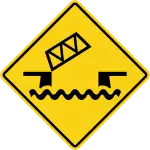 |
Not used |  |
 |
 |
Not used |  |
 |
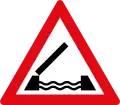 |
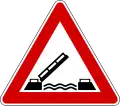 |
Not used | 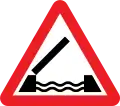 |
 | ||
| Tunnel ahead | 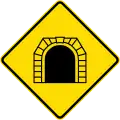 |
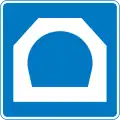 |
 |
 |
 |
 |
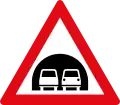 |
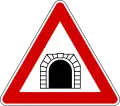 |
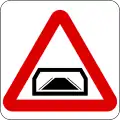 |
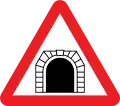 |
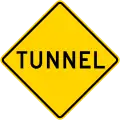 | |||||
| Height restriction ahead | 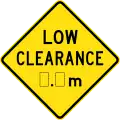 |
 |
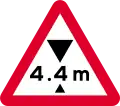 |
 |
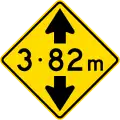 |
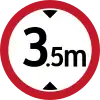 or or |
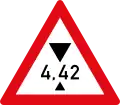 |
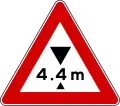 |
 |
 |
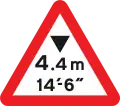 or 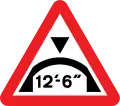 or 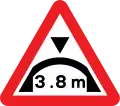 |
 | ||||
| Width restriction ahead | Not used |  |
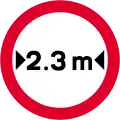 |
 |
Not used | 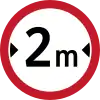 |
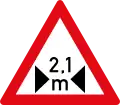 |
|||||||||
| Length restriction ahead | 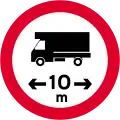 |
 |
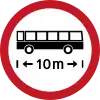 |
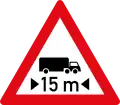 |
||||||||||||
| Weight restriction ahead | Not used |  |
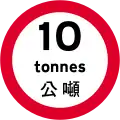 |
 |
Not used | 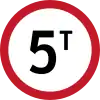 or[lower-alpha 9] 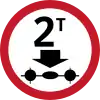 |
 | |||||||||
| Roadworks [lower-alpha 10] |
 |
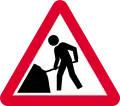 |
 |
 |
 |
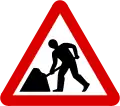 |
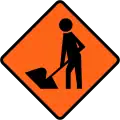 |
 |
Not used | 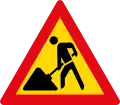 |
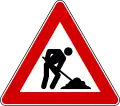 |
 |
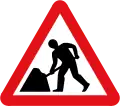 |
 | ||
| Flagman ahead |  |
 |
 |
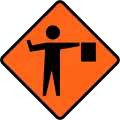 |
 |
 | ||||||||||
| Other danger | 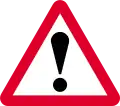 |
 |
 |
 |
 |
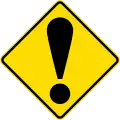 |
 |
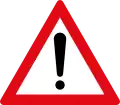 |
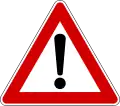 |
 |
 |
 |
||||
Regulatory
Priority
| Australia | Canada | Hong Kong | Ireland | Jamaica | Liberia | Mauritius | New Zealand | Nigeria | Philippines | SADC | Malta | Singapore | Uganda | United Kingdom | United States | |
|---|---|---|---|---|---|---|---|---|---|---|---|---|---|---|---|---|
| Stop | 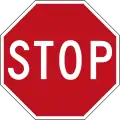 |
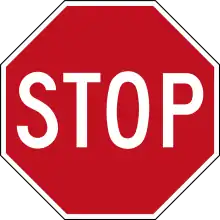 |
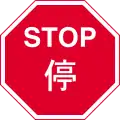 |
 |
 |
 |
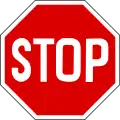 |
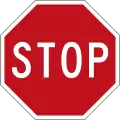 |
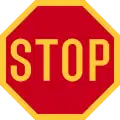 |
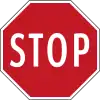 |
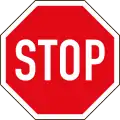 |
 |
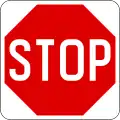 |
 |
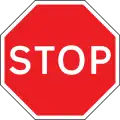 |
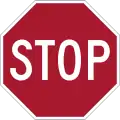 |
| Yield / Give Way | 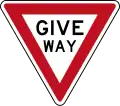 |
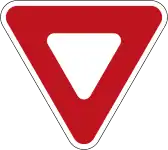 |
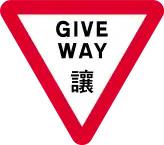 |
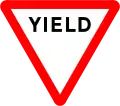 or 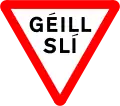 |
 |
 |
 |
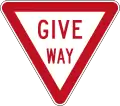 |
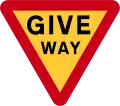 |
 |
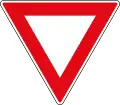 |
 |
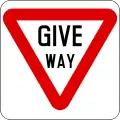 |
 |
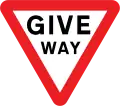 or .svg.png.webp) |
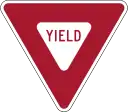 |
| Yield to oncoming traffic |  |
 |
Not used |  |
 |
 |
 |
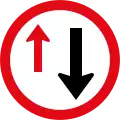 |
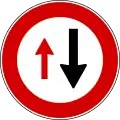 |
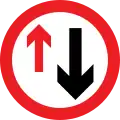 |
 |
Prohibitory
| Australia | Canada | Hong Kong | Ireland | Jamaica | Liberia | Mauritius | New Zealand | Nigeria | Philippines | SADC | Malta | Singapore | Uganda | United Kingdom | United States | |
|---|---|---|---|---|---|---|---|---|---|---|---|---|---|---|---|---|
| No entry | 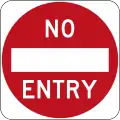 or[lower-alpha 11]  |
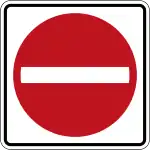 |
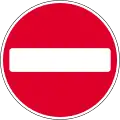 |
 or  |
 |
 [17] [17] |
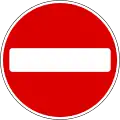 |
 |
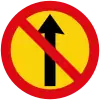 |
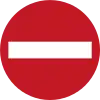 |
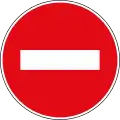 |
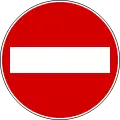 |
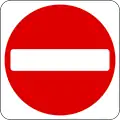 |
 |
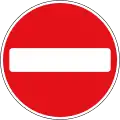 |
 |
| Road closed | or |
 |
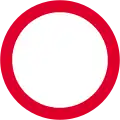 |
 |
 |
 |
 |
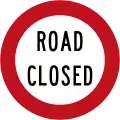 |
 |
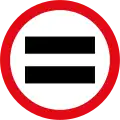 |
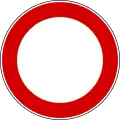 |
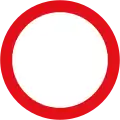 |
||||
| No motor vehicles |  |
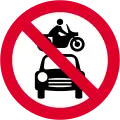 |
 |
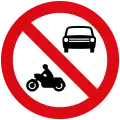 |
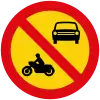 |
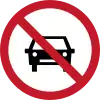 |
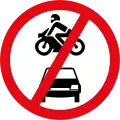 |
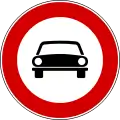 |
Not used |  |
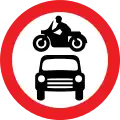 |
 | ||||
| No motorcycles |  |
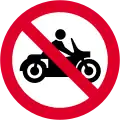 |
Not used |  |
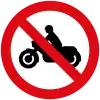 |
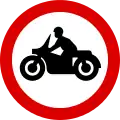 |
 |
 |
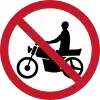 |
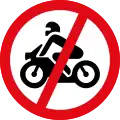 |
 |
 |
 |
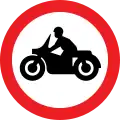 |
 | |
| No bicycles | 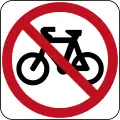 |
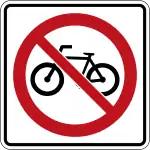 |
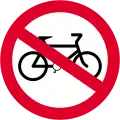 |
 |
 |
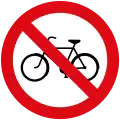 |
 |
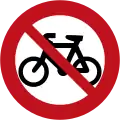 |
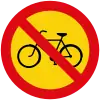 |
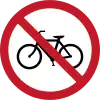 |
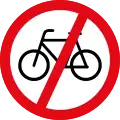 |
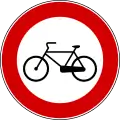 |
 |
 |
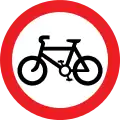 |
 |
| No pedestrians | 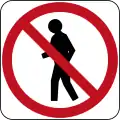 |
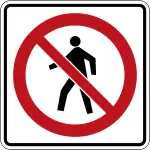 |
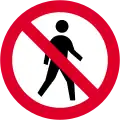 |
 |
 |
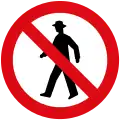 |
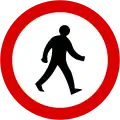 |
 |
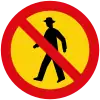 |
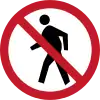 |
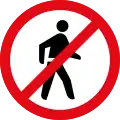 |
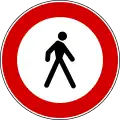 |
 |
 |
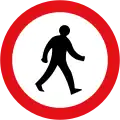 |
 or |
| No heavy goods vehicles | 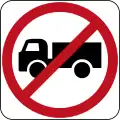 |
 |
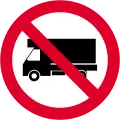 |
 |
 |
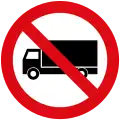 |
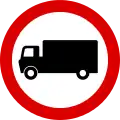 |
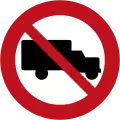 |
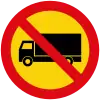 |
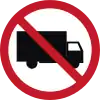 |
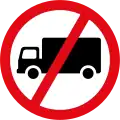 or 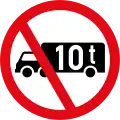 |
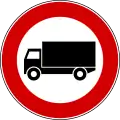 |
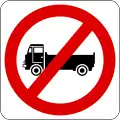 |
 |
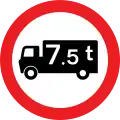 |
 or  |
| No vehicles carrying dangerous goods | 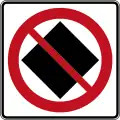 |
 |
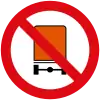 |
 |
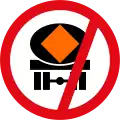 |
 |
 |
 | ||||||||
| No vehicles carrying explosives |  |
 |
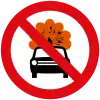 |
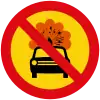 |
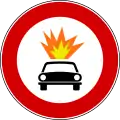 |
 |
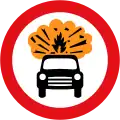 |
Not used | ||||||||
| No buses | 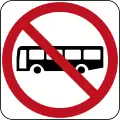 |
 |
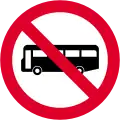 |
 |
 |
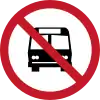 |
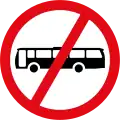 |
 |
 |
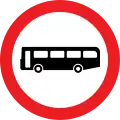 |
||||||
| Maximum speed limit | .svg.png.webp) |
 |
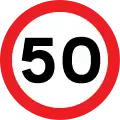 |
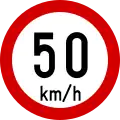 |
 |
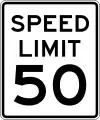 or 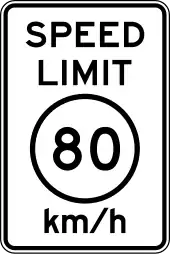 [12] [12] |
 |
.svg.png.webp) |
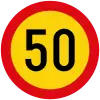 |
.svg.png.webp) |
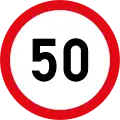 |
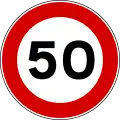 |
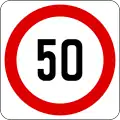 |
.svg.png.webp) |
 |
 |
| Speed restriction ends | .svg.png.webp) |
 |
Not used | 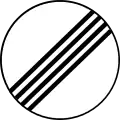 |
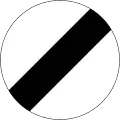 |
 |
.svg.png.webp) |
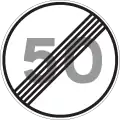 |
.svg.png.webp) |
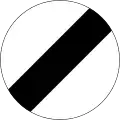 |
 | |||||
| Maximum height | 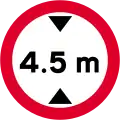 |
 |
 |
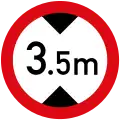 |
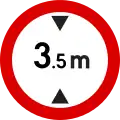 |
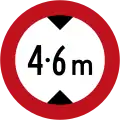 |
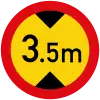 |
 |
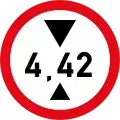 |
 |
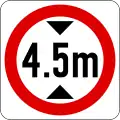 |
 |
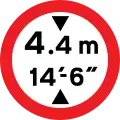 |
|||
| Maximum width | Not used |  |
 |
 |
 |
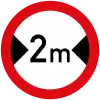 |
 |
Not used | 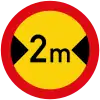 |
 |
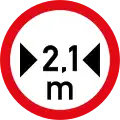 |
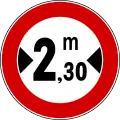 |
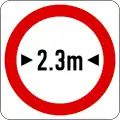 |
 |
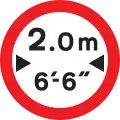 |
Not used |
| Maximum length | 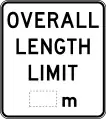 |
 |
 |
 |
 |
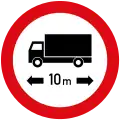 |
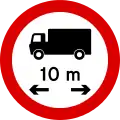 |
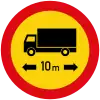 |
 |
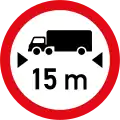 |
 |
 |
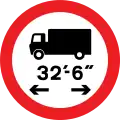 |
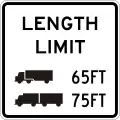 | ||
| Maximum weight |  |
 |
 |
 |
 |
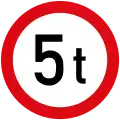 |
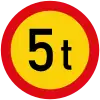 |
 |
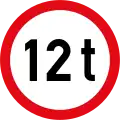 |
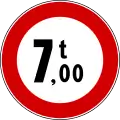 |
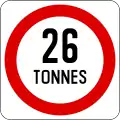 |
 |
.svg.png.webp) |
 | ||
| Maximum weight per axle |  |
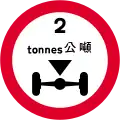 |
 |
 |
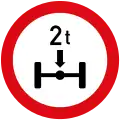 |
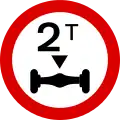 |
 |
 |
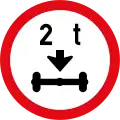 |
 |
 |
 | ||||
| No left turn | 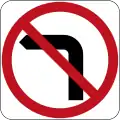 or[lower-alpha 11]  |
 |
 |
 |
 |
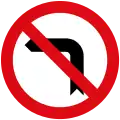 |
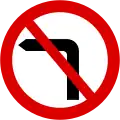 |
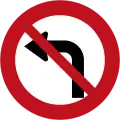 |
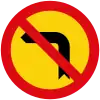 |
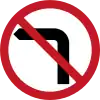 or  |
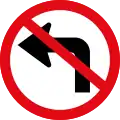 or 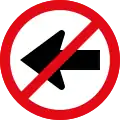 |
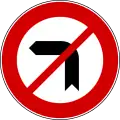 |
 |
 |
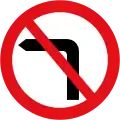 |
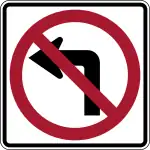 |
| No right turn | 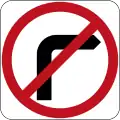 or[lower-alpha 11]  |
 |
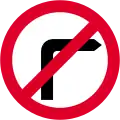 |
 |
 |
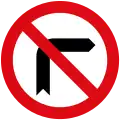 |
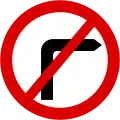 |
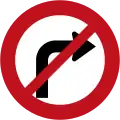 |
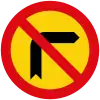 |
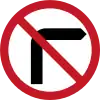 or  |
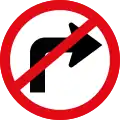 or 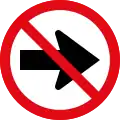 |
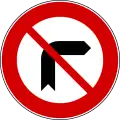 |
 |
 |
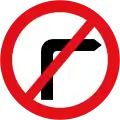 |
 |
| No U-turn | 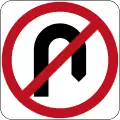 or[lower-alpha 11]  |
 |
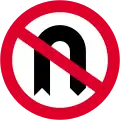 |
 |
 |
 [18] [18] |
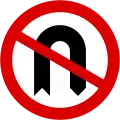 |
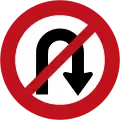 |
 |
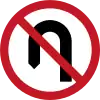 or  |
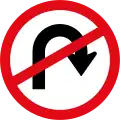 |
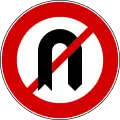 |
Not used[lower-alpha 12] |  |
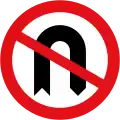 |
 |
| No overtaking |  |
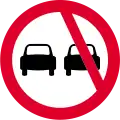 |
 |
 |
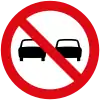 |
 |
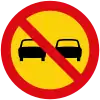 |
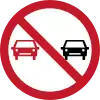 |
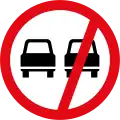 |
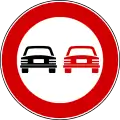 |
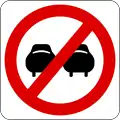 |
 |
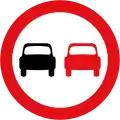 |
 or  | ||
| No parking |  |
 |
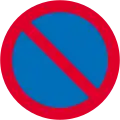 |
 |
 |
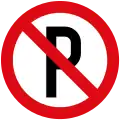 |
 |
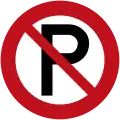 |
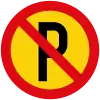 |
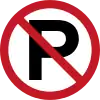 |
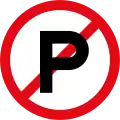 |
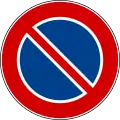 |
 |
 |
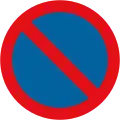 |
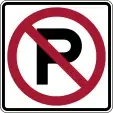 |
| No stopping |  |
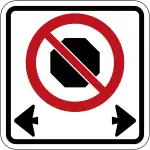 |
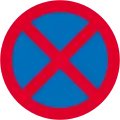 |
 |
 |
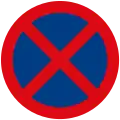 |
 |
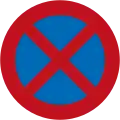 |
 |
 |
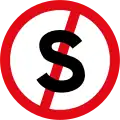 |
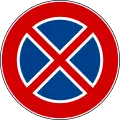 |
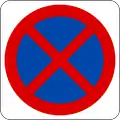 |
 |
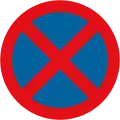 |
 |
Mandatory or permitted actions
Mandatory signs indicating an obligation to turn left do exist, but are not included in the list below since they are functionally mirror versions of signs indicating an obligation to turn right.
| Australia | Canada | Hong Kong | Ireland | Jamaica | Liberia | Mauritius | New Zealand | Nigeria | Philippines | SADC | Malta | Singapore | Uganda | United Kingdom | United States | |
|---|---|---|---|---|---|---|---|---|---|---|---|---|---|---|---|---|
| Proceed straight (no turns) |
 |
 |
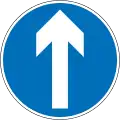 |
 |
 |
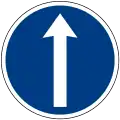 |
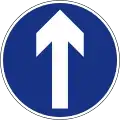 |
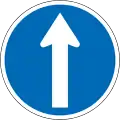 |
 |
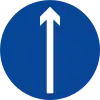 |
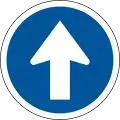 |
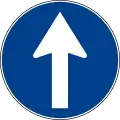 |
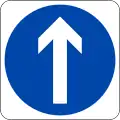 |
 |
 |
 |
| Turn right | Not used |  |
 |
 |
 |
 |
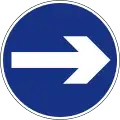 |
Not used |  |
 |
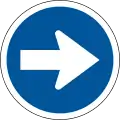 |
 |
 |
 |
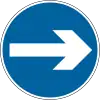 |
 |
| Turn right ahead |
 |
 |
 |
 |
 |
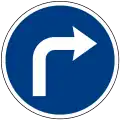 |
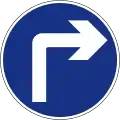 |
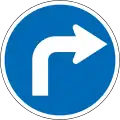 |
 |
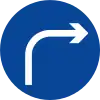 |
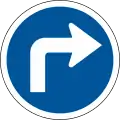 |
 |
 |
 |
 |
 |
| Proceed straight or turn right |
Not used |  |
Not used |  |
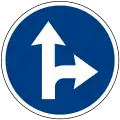 |
.svg.png.webp) |
 |
Not used | 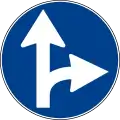 |
 |
 | |||||
| Keep right (or left) |
 |
 |
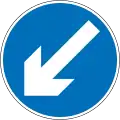 |
 |
 |
 |
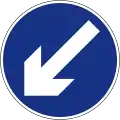 |
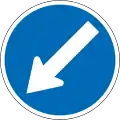 |
 |
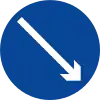 |
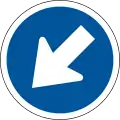 |
 |
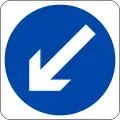 |
 |
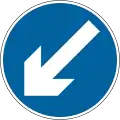 |
  |
| Pass on either side |
 |
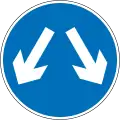 |
 |
 |
 |
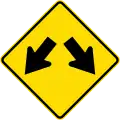 |
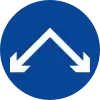 |
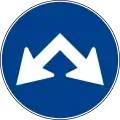 |
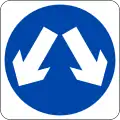 |
 |
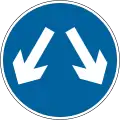 |
 | ||||
| Roundabout | 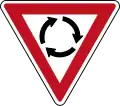 |
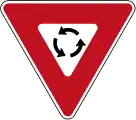 |
 |
 |
 |
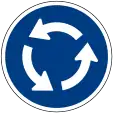 |
 |
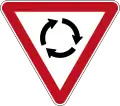 |
 |
 |
 |
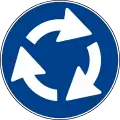 |
 |
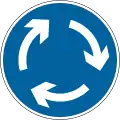 |
 | |
| Minimum speed limit | Not used |  |
Not used |  |
Not used |  |
.svg.png.webp) |
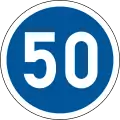 |
 |
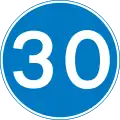 |
 | |||||
| Seatbelts required |  |
 |
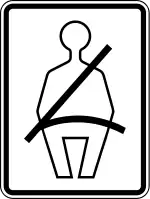 | |||||||||||||
| Overtaking permitted [lower-alpha 13] |
 |
 |
 |
 |
 |
 |
Not used |  |
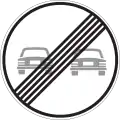 |
 |
 | |||||
| Pedestrians only | 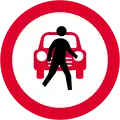 |
 |
 |
 |
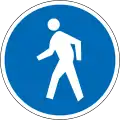 |
 |
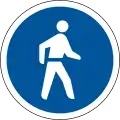 |
 |
||||||||
| Bicycles only |  |
 |
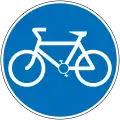 |
 |
 |
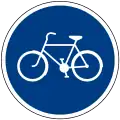 |
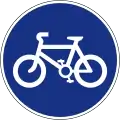 |
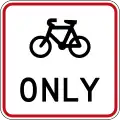 |
 |
 |
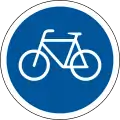 |
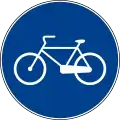 |
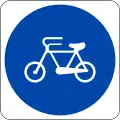 |
 |
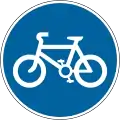 |
|
| Shared use path |  |
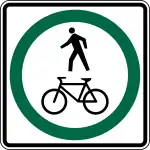 |
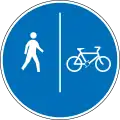 |
   |
 |
 or  |
 |
 or  |
Not used | 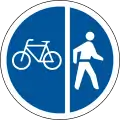 or 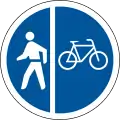 |
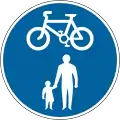 or 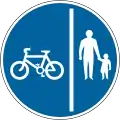 or  |
 | ||||
| Transit only |  |
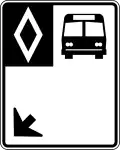 |
 |
 |
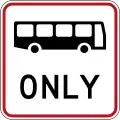 |
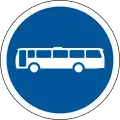 |
 |
 |
Other
| Australia | Canada | Hong Kong | Ireland | Jamaica | Liberia | Mauritius | New Zealand | Nigeria | Philippines | SADC | Malta | Singapore | Uganda | United Kingdom | United States | |
|---|---|---|---|---|---|---|---|---|---|---|---|---|---|---|---|---|
| One-way street |
 |
 |
Not used |  |
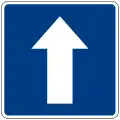 |
 |
 |
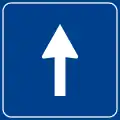 |
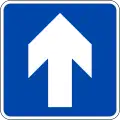 |
 |
 |
 | ||||
| Two-way traffic |
 |
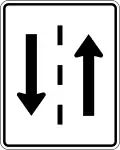 |
Not used |  |
Not used |  |
||||||||||
| Pedestrian crossing | 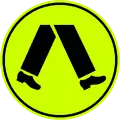 |
 |
 |
  |
 |
 |
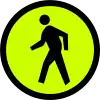 |
 |
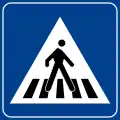 |
 |
 |
.svg.png.webp) | ||||
| Dead end |  or |
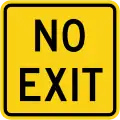 or 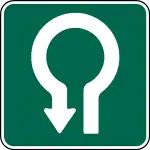 |
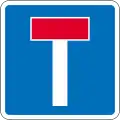 or 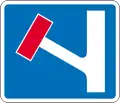 or 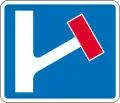 |
 or  or  |
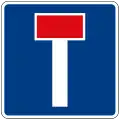 |
 or 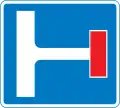 or 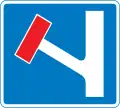 |
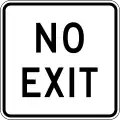 |
 |
 or  or  |
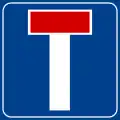 or  or 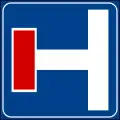 or  or  |
or or |
 |
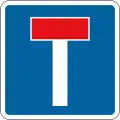 or  or  or  |
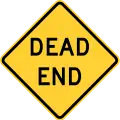 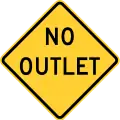 | ||
| Escape lane |  |
 or  |
 or  |
 or  or  or  |
 | |||||||||||
| Speed limit zone | .svg.png.webp) |
 |
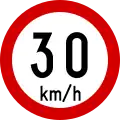 |
 |
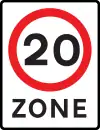 |
 | ||||||||||
| No parking zone |  |
 |
 |
 | ||||||||||||
| Parking zone |  |
 |
 |
 |
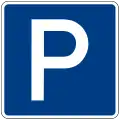 |
 |
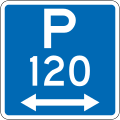 |
 |
 |
 |
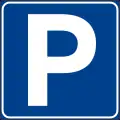 |
 |
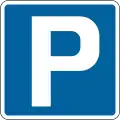 |
 | ||
| Hospital |  |
 |
 |
 |
 |
 |
 |
 |
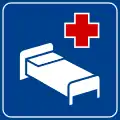 |
 |
 or 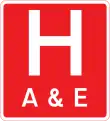 |
 | ||||
| Bus stop |  |
 |
 or |
 |
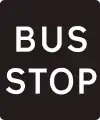 |
 |
 |
 |
 |
 |
 |
 | ||||
| Train station |  |
 |
 | |||||||||||||
| Airport |  |
 |
 |
 |
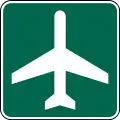 | |||||||||||
| Electric vehicle charging station |  |
 | ||||||||||||||
| Freeway begins | .svg.png.webp) |
 |
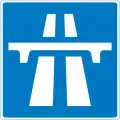 |
or |
 |
 |
||||||||||
| Freeway ends | .svg.png.webp) |
 |
 |
or |
 |
 |
 | |||||||||
| Customs post |
 |
Not used | 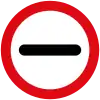 |
.svg.png.webp) |
 |
 |
Not used | |||||||||
| National highway shield(s) |
 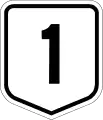 |
.svg.png.webp) |
 |
 |
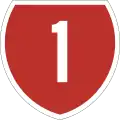 |
_sign.svg.png.webp) .svg.png.webp) .svg.png.webp) |
  |
 |
 .svg.png.webp) |
See also
Notes
- Compare Bicycles Only (Ciclovia) sign in Brazil:
 with No Bicycles (Verbot für Radfahrer) sign in Germany:
with No Bicycles (Verbot für Radfahrer) sign in Germany: 
- The last level crossing in Singapore closed in 2011, and thus train-related traffic signs became obsolete.
- The Manila tranvia system was closed long before the country adopted standardized road signs.
- Signs below used for crossroads with priority.
- The sign below is a uniquely Tanzanian version of the sign above.
- Described by the DPWH as a "reverse turn" sign.
- Top sign used in Victoria. Middle sign used in New South Wales. Bottom sign used in Queensland.
- Described by the DPWH as a "school children crossing" sign.
- The bottom sign is used for per-axle weight limits.
- Temporary use only.
- Top sign used in Queensland, South Australia, Tasmania, Victoria, and Western Australia. Bottom sign used in the Australian Capital Territory, New South Wales, and the Northern Territory.
- In Singapore, U-turns are forbidden per default, unless specifically allowed by a sign. While unofficial "U-turn prohibited" signs do exist, they only serve as a reminder, and the prohibition would still have been in place without the sign.
- In many jurisdictions, "Overtaking Permitted" is indicated solely through a change in road markings, e.g. a solid center line changing to a dashed center line. In such jurisdictions, signs in this category are only posted in locations where a change in road markings is deemed insufficient notice for drivers. This is in contrast to "No Overtaking" signs, which are almost always posted alongside changes in road markings to indicate the end of an overtaking zone.
References
- "Vienna Convention on Road Signs and Signals". United Nations Treaty Collection. Retrieved May 14, 2021.
- "Image by draperc". Mapillary. September 9, 2018. Retrieved April 21, 2019.
- "Image by draperc". Mapillary. September 9, 2018. Retrieved April 21, 2019.
- "Image by mkanyala". Mapillary. September 11, 2017. Retrieved April 21, 2019.
- "Image by mkanyala". Mapillary. September 11, 2017. Retrieved April 21, 2019.
- "Image by mkanyala". Mapillary. September 11, 2017. Retrieved April 21, 2019.
- Joseph, Dan B. (April 14, 2016). "Image by danbjoseph". Mapillary. Retrieved April 21, 2019.
- "Image by mkanyala". Mapillary. September 11, 2017. Retrieved April 21, 2019.
- "Image by mkanyala". Mapillary. September 11, 2017. Retrieved April 21, 2019.
- "Image by mkanyala". Mapillary. September 11, 2017. Retrieved April 21, 2019.
- "Image by kanyala". Mapillary. September 11, 2017. Retrieved April 21, 2019.
- Some speed limit signs are explicitly labeled in miles per hour,[2] but most are either explicitly[3][4][5][6] or implicitly measured in kilometers per hour.[7][8] Some signs use the MUTCD's metric speed limit design.[9][10][11]
- British Columbia Manual of Standard Traffic Signs & Pavement Markings
- "MUTCD HISTORY". ceprofs.civil.tamu.edu. Retrieved 2021-03-08.
- Manual on Uniform Traffic Control Devices, 2009 Edition
- "Image by draperc". Mapillary. August 18, 2018. Retrieved April 21, 2019.
- Joseph, Dan B. (April 14, 2016). "Image by danbjoseph". Mapillary. Retrieved April 21, 2019.
- "Image by draperc". Mapillary. October 11, 2018. Retrieved April 21, 2019.
- "Image by mkanyala". Mapillary. September 10, 2017. Retrieved April 21, 2019.
- "Image by draperc". Mapillary. February 25, 2019. Retrieved April 21, 2019.
_at_Exit_177_(U.S._Route_1%252C_Alexandria%252C_Fort_Belvoir)_in_Alexandria%252C_Virginia.jpg.webp)